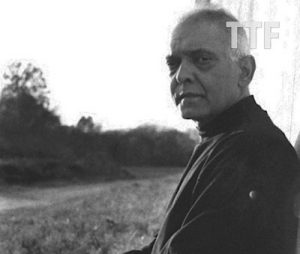Dr Eqbal Ahmed
Dr. Eqbal Ahmed was born in Bihar, India in 1933. He migrated to Pakistan in 1947. He earned his PhD in Political Science and Middle Eastern History from Princeton. He taught at University of Illinois at Chicago and Cornell University. In the 60’s he became known as one of the earliest and most vocal opponents of American policies in Vietnam and Cambodia. Dr. Ahmed died in Islamabad on May 11, 1999.
According to David Barsamain, Eqbal Ahmed was a rare combination of scholar and activist. He not only shared his knowledge with progressive movements for social change but he participated in them. He cared about people and he cared about justice.
David Barsamian is the producer of the award-winning syndicated radio program Alternative Radio. He is a regular contributor to The Progressive and Z Magazine. He interviewed Dr. Eqbal Ahmed in August 1998. Following is an excerpt from an interview with him.
Where do you trace chronologically when Islam, Muslims, Arabs become targeted as a threat or an enemy of the West?
This is not a completely new phenomenon… In the tenth century, for the first time you saw a certain notion of demonizing Islam. At that point, it wasn’t so misplaced from the European point of view, because Islam was an expansionist civilization, and therefore considered…a threat and a menace. The Crusades witnessed the first instance of demonization along religious lines, that is, demonization of Islam itself rather than of Arabs or Turks… Next you notice it in the period when British and later French colonialist encountered Muslim resistance.
There was the case of the Mahdi, who besieged and killed General Charles George Gordon in 1885 in Khartoum. That particular moment saw a great deal of emphasis on Islamic fanaticism. Colonial battles were never remembered unless a Custer was killed or a Gordon besieged. Millions of people may die, but the memories are of Custer and Gordon.
This third time… in the last 1,400 years that there is this organized attempt to demonize Islam. This time it’s more organized and sustained, because the means have changed. Today there is mass communication.
Does this process of demonization come from a shared consensus that is not articulated? Or are people meeting at Harvard and saying, “OK, we have to get together and demonize Arabs and Muslims?”
I don’t think there is a conspiracy… Great imperialism needed a legitimizing instrument to socialize people into its ethos. To do that it needed two things: a ghost and a mission. The British carried the white man’s burden. That was the mission. The French carried la mission civilisatrice, the civilizing mission. The Americans had manifest destiny and then the mission of standing watch on the walls of world freedom, in John F. Kennedy’s ringing phase. Each of them had the black, the yellow, and finally the red peril to fight against. There was a ghost and there was a mission. People bought it.
After the Cold War, Western power was deprived both of the mission and the ghost. So the mission has appeared as human rights. It’s very strange mission for a country, which for nearly a hundred years has been supporting dictatorship in Latin America and throughout the world. Chomsky and Herman wrote about this in The Washington Connection and Third World Fascism.
In search of menace, they have turned to Islam. It’s the easiest, because it has a history.
It’s also the most vulnerable.
It’s vulnerable. Its weak… Islamic countries are home to the oil resources of the West. The West has encountered resistance in Algeria, Egypt, among the Palestinians, and with the Iranian revolution-enough to arouse anxiety that Western interests… are threatened. And there is a history of demonization. All these things fall into place. And there are enough vested interests to take advantage of it.
Media coverage of Islamic fundamentalism seems to be very selective. There are certain types that are not discussed at all. For Example, the Saudi version, which may be among the most extreme. Americans hear a lot about Hezbollah and Hamas and groups in Egypt, like the Akhwan.
This is a very interesting matter you are raising… Saudi Arabia’s Islamic government has been by far the most fundamentalist in the history of Islam. Even today, for example, women drive in Iran. They can’t drive in Saudi Arabia. Today, for example, men and women work in offices together in Iran. Women wear chador, but they work in offices. In Saudi Arabia, they cannot do it. So on the basis of the nature and extent of fundamentalist principles or right-wing ideology, Saudi Arabia is much worse practice than Iran. But it has been the ally of the United States since 1932, so nobody has questioned it.
But much more than that is involved. Throughout the Cold War, starting in 1945 when it inherited its role as world power, the United States has seen militant Islam as a counter weight to communist parties in the Muslim world. During this entire period, the Muslim brotherhood in Egypt was not an enemy of the United States… The U.S. government actually promoted and supported the Islamic regime that is now in power in Sudan. General Muhammad Gaafar al-Nimeiry was allied to the Islamic movement of Sudan and was a friend.
America’s two major leverages on its allies in Western Europe and Asia-the nuclear umbrella and economic superiority-had drastically diminished by the early 1970’s. The U.S. was looking for new leverages over its allies. They picked the Middle East because this was where the energy resources for the industrial economies of Japan and Europe came from. An established, unchallenged American influence in this Region… could control prices and show Europe and Japan, “We can give you cheap oil. We can make your oil expensive. We hold your economic lifeline.”
This was the time of the Nixon Doctrine, namely, the use of regional powers to police the region for the United States. In the Middle East, they chose Iran and Israel. In the Pentagon, throughout most of the 1970s, they were called “our two eyes in the Middle East.” In 1978, after having or perhaps because of having taken some $20 billion of military hardware from the United States, the shah of Iran fell under weight of his own militarization. The 1979 Islamic revolution threatened American interests deeply… materializing in an uglier form during the hostage crisis.
Within a year, quite ironically, something totally the opposite happens. The Soviet Union intervened in Afghanistan. In Pakistan, an Islamic fundamentalist of a really hardcore variety, the mujahideen in Afghanistan, takes on the “evil empire.” They received billions in arms between 1981 and 1988 from the United States alone. Add additional support form Saudi Arabia, under American encouragement… American operatives went about the Muslim world recruiting for the jihad in Afghanistan, because the U.S. saw it as an opportunity to mobilize the Muslim world against communism. That opportunity was exploited by recruiting mujahideen in Algeria, Sudan, Egypt, Yemen, and Palestine. From everywhere they came. They received training from the CIA. They received arms from the CIA. I have argued in some of my writings that the notion of jihad as “just struggle” had not existed in the Muslim world since the tenth century until the United States revived it during its jihad against the Soviet Union in Afghanistan.
Since then, almost every Islamic militant, including those in Israel, Algeria, and Egypt… has been trained in Afghanistan. The CIA people call it “Islamic blowback.”
These are aspects that the American media is not willing to touch on. The New York Times’ foreign affairs columnist are neither qualified nor would they want to be qualified to comment on these realities.
“Eqbal Ahmad was that rare thing, an intellectual unintimitated by power or authority…Perhaps the shrewdest and most original anti-imperialist of Asia and Africa.” -Edward W. Said
Source: Islamicity
FOLLOW US ALSO VIA THE FOLLOWING LINKS:
Raggie Jessy Rithaudeen on Twitter
Raggie Jessy Rithaudeen on Facebook
TowardsGE15 on Facebook
Gagasan Tiga (G3) on Facebook
The Third Force (Telegram)




